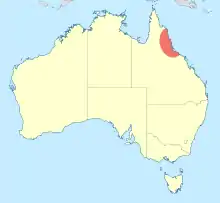Petalura ingentissima
Petalura ingentissima, the giant petaltail, has been described as the world's largest dragonfly, with a wingspan of 160 mm.[3] It is found in Queensland, Australia.[4]
| Giant petaltail | |
|---|---|
| Scientific classification | |
| Kingdom: | Animalia |
| Phylum: | Arthropoda |
| Class: | Insecta |
| Order: | Odonata |
| Infraorder: | Anisoptera |
| Family: | Petaluridae |
| Genus: | Petalura |
| Species: | P. ingentissima |
| Binomial name | |
| Petalura ingentissima | |
 | |
Dr R.J. Tillyard described the giant petaltail in 1908.[2] Its species name is derived from the Latin adjective ingens "huge". It is one of five species in the Australian genus Petalura.[5]
A large heavily built dragonfly,[5] the giant petaltail has a black body with some yellow markings.[6] The female's wingspan can be 158–162 mm and body length 125 mm, the largest dragonfly species in overall dimensions although members of the genus Tetracanthagyna can have longer wings and Chlorogomphus papilio a larger wing area.[7]
Measuring 5.9-6.3 cm long,[6] the larvae are unusual in that they live in burrows along the river margin and hunt passing prey.[5]
Gallery
.jpg.webp) Female wings
Female wings.jpg.webp) Male wings
Male wings
See also
References
| Wikimedia Commons has media related to Petalura ingentissima. |
| Wikispecies has information related to Petalura ingentissima. |
- Dow, R.A. (2017). "Petalura ingentissima". IUCN Red List of Threatened Species. 2017: e.T87536260A87540079. doi:10.2305/IUCN.UK.2017-1.RLTS.T87536260A87540079.en.
- Tillyard, R. (1908). "On the genus Petalura, with description of a new species". Proceedings of the Linnean Society of New South Wales. 32: 708–718. doi:10.5962/bhl.part.19584 – via Biodiversity Heritage Library.
- "Petalura ingentissima Tillyard". CSIRO website. CSIRO. 19 September 2004. Retrieved 14 May 2013.
- "Species Petalura ingentissima Tillyard, 1908". Australian Faunal Directory. Australian Biological Resources Study. 2012. Retrieved 23 April 2017.
- "Petaluridae". What Bug is That - The Guide to Australian Insect Families. CSIRO. 2013. Retrieved 14 May 2013.
- Günther Theischinger, John Henry Hawking (2006). The complete field guide to dragonflies of Australia. CSIRO Publishing. p. 110. ISBN 0643090738.
- Silsby, Jill (2001). Dragonflies of the World. CSIRO Publishing. p. 37. ISBN 0643065121.
